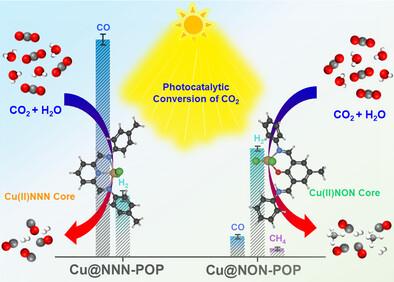Tailoring the Cu2+ Coordination Microenvironment in Porous Organic Frameworks for Switchable CO2 Photoreduction to CO or CH4
IF 12.1
2区 材料科学
Q1 CHEMISTRY, MULTIDISCIPLINARY
引用次数: 0
Abstract
Solar-driven conversion of CO2 to fuels addresses both energy and environmental crises. This study reports the rational design and synthesis of two heteroatom-enriched imine-based porous organic frameworks (POFs), NON-POF and NNN-POF, further functionalized with copper sites (Cu@NON-POF and Cu@NNN-POF) for photocatalytic CO2 reduction under visible light. Notably, Cu@NNN-POF exhibits exceptional CO production with a remarkable yield of 4.86 mmol g−1, whereas Cu@NON-POF enables an 8-electron reduction pathway, selectively producing CH4 (0.18 mmol g−1) alongside notable amounts of CO and H2. The enhanced CH4 selectivity in Cu@NON-POF arose from the distinct hydrogen-bonding interactions between its N-H moieties and CO2 intermediates, which promotes multi-step hydrogenation. Spectroscopic and theoretical analyses reveal how structural and electronic properties govern catalytic activity and product selectivity. Operando extended X-ray absorption fine structure (EXAFS) studies provide crucial insights into the dynamic coordination environment, oxidation states, and structural evolution of Cu active sites under operational conditions, clarifying the mechanistic basis for product selectivity. This work highlights the potential of Cu-incorporated POFs as robust and cost-effective systems for solar-driven CO2 reduction, advancing catalytic design strategies for clean energy production. Additionally, the mechanistic investigations emphasized the pivotal role of ligand architecture and metal coordination environments in tailoring product selectivity during photocatalytic CO2 reduction.

可切换CO2光还原为CO或CH4的多孔有机框架中Cu2+配位微环境的调整
太阳能驱动的二氧化碳转化为燃料解决了能源和环境危机。本研究报道了两种富杂原子亚胺基多孔有机骨架(NON-POF和NNN-POF)的合理设计和合成,并通过铜位点(Cu@NON-POF和Cu@NNN-POF)进一步功能化,用于可见光下光催化CO2还原。值得注意的是,Cu@NNN-POF的CO产量高达4.86 mmol g−1,而Cu@NON-POF则采用8电子还原途径,选择性地产生CH4 (0.18 mmol g−1)以及大量的CO和H2。Cu@NON-POF中CH4选择性的增强是由于其N-H基团与CO2中间体之间存在明显的氢键相互作用,促进了多步加氢。光谱和理论分析揭示了结构和电子性质如何控制催化活性和产物选择性。Operando扩展x射线吸收精细结构(EXAFS)研究为Cu活性位点在操作条件下的动态配位环境、氧化态和结构演化提供了重要的见解,阐明了产物选择性的机理基础。这项工作强调了cu结合POFs作为太阳能驱动的二氧化碳减排的强大且具有成本效益的系统的潜力,推进了清洁能源生产的催化设计策略。此外,机理研究强调了光催化CO2还原过程中配体结构和金属配位环境在调整产物选择性方面的关键作用。
本文章由计算机程序翻译,如有差异,请以英文原文为准。
求助全文
约1分钟内获得全文
求助全文
来源期刊

Small
工程技术-材料科学:综合
CiteScore
17.70
自引率
3.80%
发文量
1830
审稿时长
2.1 months
期刊介绍:
Small serves as an exceptional platform for both experimental and theoretical studies in fundamental and applied interdisciplinary research at the nano- and microscale. The journal offers a compelling mix of peer-reviewed Research Articles, Reviews, Perspectives, and Comments.
With a remarkable 2022 Journal Impact Factor of 13.3 (Journal Citation Reports from Clarivate Analytics, 2023), Small remains among the top multidisciplinary journals, covering a wide range of topics at the interface of materials science, chemistry, physics, engineering, medicine, and biology.
Small's readership includes biochemists, biologists, biomedical scientists, chemists, engineers, information technologists, materials scientists, physicists, and theoreticians alike.
 求助内容:
求助内容: 应助结果提醒方式:
应助结果提醒方式:


